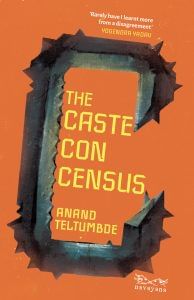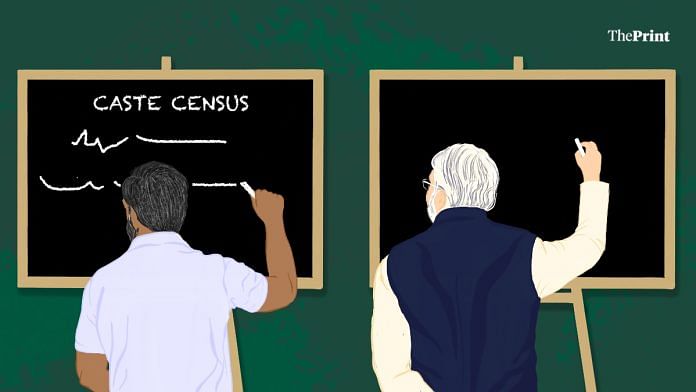In his new book, The Caste Con Census, Anand Teltumbde argues that a caste census will be just another means of keeping the caste system going. In this excerpt, he discusses why Narendra Modi aims to reclaim narrative leadership around caste from regional parties such as the RJD in Bihar and the JD(S) in Karnataka.
Regional parties such as the RJD in Bihar and the JD(S) in Karnataka trace their lineage directly to the Mandal moment of the late 1970s and early 1980s, when OBC mobilization shattered upper-caste hegemony and reconfigured Indian democracy. For them, caste enumeration is no mere technical exercise but a radical tool of power redistribution; one that underpins demands for land reform, sub-categorization of OBC quotas and proportional representation in legislatures, bureaucracy and local bodies.
Lalu Prasad Yadav’s framing of ‘Mandal versus Kamandal’ exemplified this binary: The caste census here is a weapon to dismantle inherited privilege and enshrine OBC, Dalit and Muslim interests in India’s governing institutions. By contrast, the Congress, from its Nehruvian suspicion of caste to Indira Gandhi’s sidelining of the Kalelkar and Mandal commissions, has historically regarded caste data as a divisive relic of colonial rule.
Voter Bases and Mobilization Strategies
The RJD and the JD(S) draw their lifeblood from grassroot caste coalitions, be it Bihar’s Yadav–Muslim–Dalit axis or Karnataka’s Lingayat–Vokkaliga–OBC electorate. Their caste surveys—like Nitish Kumar’s 2023 Bihar exercise—are conducted swiftly, transparently and with direct outreach through local cadres, vernacular media and community rallies. These parties weave caste enumeration into a larger narrative of dignity, restitution and collective bargaining. The Congress, by contrast, remains hamstrung by its urban–elite image and fears of alienating its Savarna constituents. Rahul Gandhi may have rejigged the Kanshi Ram slogan as ‘Jitni Abadi, Utna Haq’ (match your might with your right), but his party lacks grassroot machinery—caste networks, local organizers and coalition partners—to convert rhetoric into electoral strength. Its promise of a caste census hence rings hollow, and is viewed by many voters as an electoral token rather than the first step toward systemic change.
Also read: Caste census is a bad idea whose time has come. Much worse lies ahead
Policy Substance versus Electoral Optics
Regional parties couple their census demands with concrete policy blueprints: OBC sub-categorization to prevent quota capture by dominant subgroups, reservations in panchayat and municipal bodies and measures to correct historical welfare imbalances. They have enacted or overseen state-level surveys, demonstrating both capacity and conviction.
The Congress’s position, however, remains vague: While it now champions census calls, it has neither conducted state surveys in its own strongholds (e.g., Rajasthan, Chhattisgarh) nor articulated how new data will inform land redistribution, job quotas or educational access. Until it builds caste-anchored organizations and forges genuine alliances with radical OBC and Dalit parties, its caste census advocacy will remain a façade, an attempt to reclaim relevance rather than reshape the social order.
The Modi government’s decision to include caste enumeration directly undercuts the BJP’s ideological project of Hindu unity. To manage this contradiction, the party invokes the Hindutva narrative that caste politics divides Hindu society, while simultaneously projecting Modi as a leader ‘above caste’. This image, carefully curated by mainstream media and digital influencers, conceals a regime that thrives on caste-calibrated electoral engineering.
By announcing a caste census, Modi aims to pre-empt this Mandal 2.0 momentum and reclaim narrative leadership. However, critical questions remain unanswered: Will it enumerate all castes, including dominant ones? Will it collect socio-economic data (landholding, education, income, occupation, assets and liabilities) or merely count heads?
Even if caste data is collected for all communities, including the upper castes, like the Bihar survey did, the question remains: What policy implications will they have? Caste is not a discrete or flat category but a graded continuum that resists precise measurement. Any caste census, however detailed, will inevitably treat different castes as discrete entities, thereby reducing them to aggregates of sub-castes with significant internal disparities. Consider the extreme example of Brahmins in Bihar, who comprise at least six sub-castes: Maithil, Saryuparin, Kanyakubja, Sakaldwipi, migrant groups and Bhumihar. These range from the highly privileged Maithils to the relatively deprived Sakaldwipis. Similar hierarchies exist within every caste, rendering the census incapable of capturing real inequality.
This is the core argument against the caste census that this book makes: If equality is the aim, a caste census can never deliver it. On the contrary, it risks unleashing caste turbulence, as history shows, which will likely outweigh potential gains many times over. A more workable approach is to universalize the foundations of capacity-building while retaining existing reservation schemes as a pragmatic step open for future review. The greater danger, however, is political. The BJP is likely to weaponize caste data to dismantle caste-based reservations and shift focus to economic criteria as indicators of measuring backwardness—fulfilling its long-standing ideological project.
It is extremely important to recognize that a caste census is not merely a data-collection exercise; it is a tool of socio-political engineering that can shape its subjects in pernicious ways, often to the advantage of those who control it. This is how the history of caste enumeration has borne out. Therefore, if such an exercise is inevitable, given the widespread support it enjoys in political and progressive circles, it is advisable to place it under the supervision of an independent body comprising social scientists, data analysis experts and public policy specialists.
The data regime under Modi reveals an unambiguous political calculus: Collect exhaustive data on the population, but not on the state; digitize the citizen, but obscure the system; promise transparency, but practice opacity. Whether it is the deferral of the census, suppression of employment and health data or selective digitization of welfare, the government’s actions have invariably tended to prevent data from becoming a site of democratic accountability. Its selective use of data is a mechanism of both governance and ideological reproduction.
Without a transparent methodology and independent oversight, the caste census risks becoming yet another tool of data management rather than redistribution. In the end, the question is not whether India will be governed by data—but who controls it and for what purpose.
While much attention has been drawn to the likely consequences of the forthcoming caste census on reservation policy—such as the demand to breach the 50 per cent ceiling or to create sub-quotas within OBCs—the potential political utility of its findings extends beyond this domain. What is at stake is not merely statistical enumeration, but the power to restructure India’s socio-political landscape through selective visibility and calibrated invisibility. The data may serve less as an instrument of redistribution than one of renewed legitimation of existing hierarchies and a realignment of social blocks, particularly in ways that retain the dominance of the upper castes while projecting a commitment to backward communities.
 This is an edited excerpt where the academic notes and references have been removed. Excerpted with permission from Navayana.
This is an edited excerpt where the academic notes and references have been removed. Excerpted with permission from Navayana.






